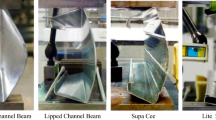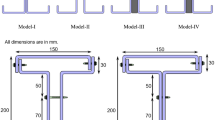Abstract
Cold-formed thin-walled steel hollow flange beam (HFB) has been emerged and utilised structurally. It is composed of one or two closed flanges with high torsional stiffness and relatively flexible web. Hence, the global stability of such beam has greatly been improved compared with conventional I-beams with flat flanges, due to their superior torsional stiffness and stability. However, under concentrated loading, local flange deformation occurs easily at the load-action-region, because the tubular flange is hollow even if stiffeners are attached to the webs. Up-to-date, rather than filling the tubular flange with concrete, there is not any relevant literature or reports on how to improve the local buckling state of the hollow flange I-beams. Accordingly, in this paper, a stiffened compression rectangular hollow flange beam (SCHFB) is presented, from which the web penetrates the bottom wall of the top tubular flange until it reaches its top wall. By doing so, several concentrated loads may be applied safely on the beams or the segmental lunching technique may successfully be used to erect the beam in its place. This paper examines experimentally this stiffened beam and then extends to use the finite element modelling to replicate the actual behaviour of the beam. A numerical comparison between the SCHFB, conventional CHFB and I-beam shows that the ultimate bearing capacity and ductility are significantly enhanced in the case of SCHFB compared with the other two beams. Additionally, the SCHFB has been found to own better local deformation performance than that of the CHFB. However, with the span increase, the vertical concave deformation, lateral deformations at top flange and vertical deformations of top flange plate of the tubes of the SCHFB and CHFB may approach each other. So, the SCHFB becomes the best choice for short-span beams under either concentrated or distributed loading.

























Similar content being viewed by others
Availability of data and material
Available upon request.
References
ABAQUS (2008). ABAQUS Standard User’s Manual. The Abaqus Software is a product of Dassault Systèmes Simulia Corp.
Anapayan, T., & Mahendran, M. (2012). Improved design rules for hollow flange sections subject to lateral distortional buckling. Thin-Walled Structures, 50(1), 128–140. https://doi.org/10.1016/j.tws.2011.09.004.
Anapayan, T., Mahendran, M., & Mahaarachchi, D. (2011). Lateral distortional buckling tests of a new hollow flange channel beam. Thin-Walled Structures, 49(1), 13–25. https://doi.org/10.1016/j.tws.2010.08.003.
Avery, P., & Mahendran, M. (1997). Finite-element analysis of hollow flange beams with web stiffeners. Journal of Structural Engineering, 123(9), 1123–1129. https://doi.org/10.1061/(asce)0733-9445(1997)123:9(1123).
Couto, C., & Vila Real, P. (2019). Numerical investigation on the influence of imperfections in the local buckling of thin-walled I-shaped sections. Thin-Walled Structures, 135, 89–108. https://doi.org/10.1016/j.tws.2018.10.039.
Dong, J., & Sause, R. (2009). Flexural strength of tubular flange girders. Journal of Constructional Steel Research, 65(3), 622–630. https://doi.org/10.1016/j.jcsr.2008.02.019.
El-Khoriby, S. R., Hassanein, M. F., Kharoob, O. F., El Hadidy, A. M., & Alnaggar, G. A. N. (2016). Tubular flange plate girders with corner square web openings in the panel of maximum shear: Strength and behaviour. Thin-Walled Structures, 99, 142–154. https://doi.org/10.1016/j.tws.2015.11.014.
GB/T228-2010. (2010). Metallic materials—tensile test method at room temperature.
Hassanein, M. F., & Kharoob, O. F. (2010). Shear strength and behavior of transversely stiffened tubular flange plate girders. Engineering Structures, 32(9), 2617–2630. https://doi.org/10.1016/j.engstruct.2010.04.034.
Hassanein, M. F., & Kharoob, O. F. (2012). An extended evaluation for the shear behavior of hollow tubular flange plate girders. Thin-Walled Structures, 56, 88–102. https://doi.org/10.1016/j.tws.2012.03.020.
Hassanein, M. F., & Kharoob, O. F. (2013). Flexural strength of hollow tubular flange plate girders with slender stiffened webs under mid-span concentrated loads. Thin-Walled Structures, 69, 18–28. https://doi.org/10.1016/j.tws.2013.03.016.
Hassanein, M. F., Kharoob, O. F., & El Hadidy, A. M. (2013). Lateral–torsional buckling of hollow tubular flange plate girders with slender stiffened webs. Thin-Walled Structures, 65, 49–61. https://doi.org/10.1016/j.tws.2013.01.006.
Hassanein, M. F., & Silvestre, N. (2013). Lateral–distortional buckling of hollow tubular flange plate girders with slender unstiffened webs. Engineering Structures, 56, 572–584. https://doi.org/10.1016/j.engstruct.2013.05.028.
Jáger, B., Kövesdi, B., & Dunai, L. (2019). Numerical investigations on bending and shear buckling interaction of I-Girders with slender WEB. Thin-Walled Structures. https://doi.org/10.1016/j.tws.2019.106199.
Keerthan, P., & Mahendran, M. (2016). Shear tests of rivet fastened rectangular hollow flange channel beams. Journal of Constructional Steel Research, 121, 330–340. https://doi.org/10.1016/j.jcsr.2016.02.016.
Keerthan, P., Mahendran, M., & Steau, E. (2014). Experimental study of web crippling behaviour of hollow flange channel beams under two flange load cases. Thin-Walled Structures, 85, 207–219. https://doi.org/10.1016/j.tws.2014.08.011.
Lalthazuala, R., & Singh, K. D. (2019). Investigations on structural performance of hybrid stainless steel I-beams based on slenderness. Thin-Walled Structures, 137, 197–212. https://doi.org/10.1016/j.tws.2019.01.006.
Liu, R. F., & Wu, Z. Y. (2008). Effect of web stiffeners on the load-carrying capacity of hollow flange beam LHFB. Journal of Harbin Institute of Technology, 40(6), 855–859.
Mohebkhah, A., & Azandariani, M. G. (2015). Lateral–torsional buckling of Delta hollow flange beams under moment gradient. Thin-Walled Structures, 86, 167–173. https://doi.org/10.1016/j.tws.2014.10.011.
Perera, N., & Mahendran, M. (2018). Section moment capacity tests of hollow flange steel plate girders. Journal of Constructional Steel Research, 148, 97–111. https://doi.org/10.1016/j.jcsr.2018.04.034.
Perera, N., & Mahendran, M. (2019). Finite element analysis and design for section moment capacities of hollow flange steel plate girders. Thin-Walled Structures, 135, 356–375. https://doi.org/10.1016/j.tws.2018.10.014.
Pi, Y. L., & Trahair, N. S. (1997). Lateral-distortional buckling of hollow flange beams. Journal of Structural Engineering, 123(6), 695–702. https://doi.org/10.1061/(asce)0733-9445(1997)123:6(695).
Shao, Y. B., & Wang, Y. M. (2017). Experimental study on static behavior of I-girder with concrete-filled rectangular flange and corrugated web under concentrated load at mid-span. Engineering Structures, 130, 124–141. https://doi.org/10.1016/j.engstruct.2016.10.002.
Siahaan, R., Keerthan, P., & Mahendran, M. (2018). Lateral distortional buckling of rivet fastened rectangular hollow flange channel beams. Journal of Constructional Steel Research, 144, 295–309. https://doi.org/10.1016/j.jcsr.2018.01.003.
Steau, E., Mahendran, M., & Keerthan, P. (2015). Web crippling tests of rivet fastened rectangular hollow flange channel beams under two flange load cases. Thin-Walled Structures, 95, 262–275. https://doi.org/10.1016/j.tws.2015.06.008.
Tondini, N., & Morbioli, A. (2015). Cross-sectional flexural capacity of cold-formed laterally-restrained steel rectangular hollow flange beams. Thin-Walled Structures, 95, 196–207. https://doi.org/10.1016/j.tws.2015.06.018.
Trahair, N. S., & Papangelis, J. P. (2018). Lateral-distortional buckling of beams with hollow flanges and folded plate webs. Engineering Structures, 163, 71–76. https://doi.org/10.1016/j.engstruct.2018.02.001.
Wang, X., & Lambert, S. B. (2003). On the calculation of stress intensity factors for surface cracks in welded pipe–plate and tubular joints. International Journal of Fatigue, 25(1), 89–96. https://doi.org/10.1016/S0142-1123(02)00045-2.
Wanniarachchi, K. S., & Mahendran, M. (2017). Experimental study of the section moment capacity of cold-formed and screw-fastened rectangular hollow flange beams. Thin-Walled Structures, 119, 499–509. https://doi.org/10.1016/j.tws.2017.05.033.
Yu, N. T., Kim, B., Yuan, W. B., Li, L. Y., & Yu, F. (2019). An analytical solution of distortional buckling resistance of cold-formed steel channel-section beams with web openings. Thin-Walled Structures, 135, 446–452. https://doi.org/10.1016/j.tws.2018.11.012.
Funding
This work is supported by the Scientific Innovation Group for Youths of Sichuan Province under Grant No.2019JDTD0017.
Author information
Authors and Affiliations
Corresponding author
Ethics declarations
Conflict of interest
On behalf of all authors, the corresponding author states that there is no conflict of interest.
Additional information
Publisher's Note
Springer Nature remains neutral with regard to jurisdictional claims in published maps and institutional affiliations.
Rights and permissions
About this article
Cite this article
Shao, Y.B., Mohamed, H.S., Wang, L. et al. Experimental and Numerical Investigation on Stiffened Rectangular Hollow Flange Beam. Int J Steel Struct 20, 1564–1581 (2020). https://doi.org/10.1007/s13296-020-00390-w
Received:
Accepted:
Published:
Issue Date:
DOI: https://doi.org/10.1007/s13296-020-00390-w




